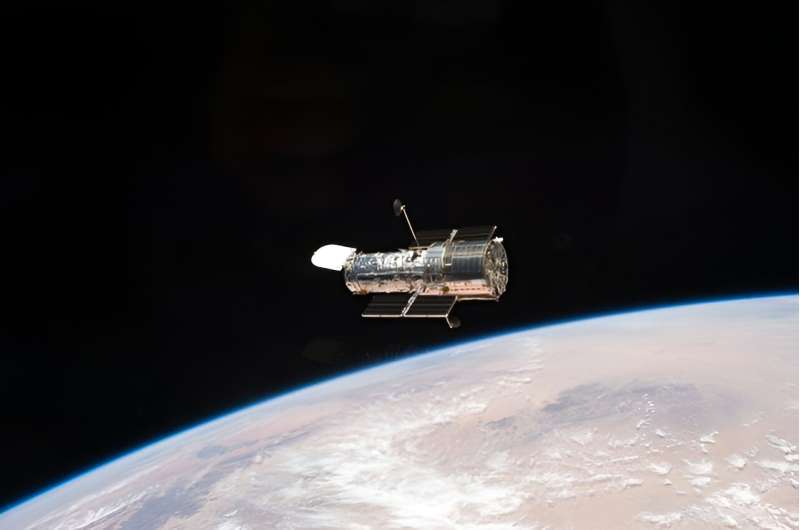This article has been reviewed according to Science X's editorial process and policies. Editors have highlighted the following attributes while ensuring the content's credibility:
fact-checked
trusted source
proofread
It's time for hardworking Hubble to slow down a little

Thirty-four years is a long time for a telescope. Yet, that is how long the veteran workhorse of NASA's space telescope fleet has been operating. Admittedly, Hubble was served by several repair missions during the space shuttle era.
Still, the system has been floating in the void and taking some of humanity's most breathtaking pictures ever captured since April 24, 1990. But now, time seems to be finally catching up with it, as NASA plans to limit some of its operations to ensure its continued life, starting with gyroscopes.
Hubble has six gyroscopes, which are intended to help it orient in the right direction and ensure it stays oriented in that direction while it takes the extremely long-exposure, detailed images it is famous for.
The six gyroscopes currently installed replaced six older ones during the final shuttle servicing mission in 2009. As one of the few moving components on Hubble, lasting 15 years without maintenance is pretty impressive.
That being said, not all of them lasted that long—only three are operational at this point, with the other three having failed at some point over the last 15 years. And on May 24, the telescope was sent into safe mode by another failed gyro.
This isn't the first time that particular problem has happened either. Previous errors caused by the same gyro have caused Hubble to go into safe mode multiple times over the past few months. While engineers can reset it, the same problem repeatedly happening means it will probably continue.
The problem is that the gyro is "saturating," meaning that the sensor that shows its speed is maxing out even when the gyro itself isn't moving near that speed. Since the spacecraft slewing at maximum speed could cause potential issues, the safe thing to do when reading a maximum speed on a gyro is to go into "safe mode" and ensure the spacecraft doesn't wildly swing in one direction.
Operating in that mode makes sense, especially if the sensor readings are correct, but they make it almost impossible to move accurately if sensor readings aren't correct. Given the previous efforts by Hubble's engineering team to fix the problem, it appears at least one of the three remaining gyros is effectively inoperable from now on. So, the team now has a choice.
They could continue to operate with two gyros, or they could only use one and alternate which one they are using to not cause undue wear and tear on whichever one is selected for service first.
According to a press release from the agency, operating with two gyros is effectively the same as operating with one, whereas operating with three had significant advantages in terms of speed and accuracy. So, the engineering team has decided that Hubble will operate in one gyro mode from now on.
This isn't the first time it's done so—Hubble effectively operated in one-gryo mode for a short time back in 2008 when the previous set of gyros was failing. It also operated in two-gyro mode from 2005 to 2009, when all the original gyros were replaced. So it is certainly possible, but what impact will it have?
It will take longer to lock on to targets, which is hardly surprising given the telescope's age, but detrimental if it was hoping to catch transient events such as a supernova. It also won't be able to track any moving objects that are closer than Mars, such as the occasional comet or asteroid.
Typically, those types of objects weren't the focal point of Hubble's observations anyway. While Hubble will indeed have to slow down, its support team believes it can continue operations through at least the rest of this decade in this new mode.
Luckily, it is no longer alone in its role as the workhorse space telescope. The James Webb Space Telescope has far surpassed its observational capabilities; the Nancy Grace Roman Telescope, due to launch in 2027, will contribute additional functionality to make up for Hubble's slowing pace.
Hubble itself will always have a place in astronomy nerds' hearts. Its Deep Field image is my favorite picture and sparked my love for astronomy as a kid. And I'm not alone—NASA recently rejected billionaire Jared Isaacman's plan to service the aging telescope as part of a series of Dragon capsule missions.
But even without additional help from the ground, Hubble hopefully still has a long, fruitful life ahead of it when it continues its science operations in mid-June.
Provided by Universe Today





















